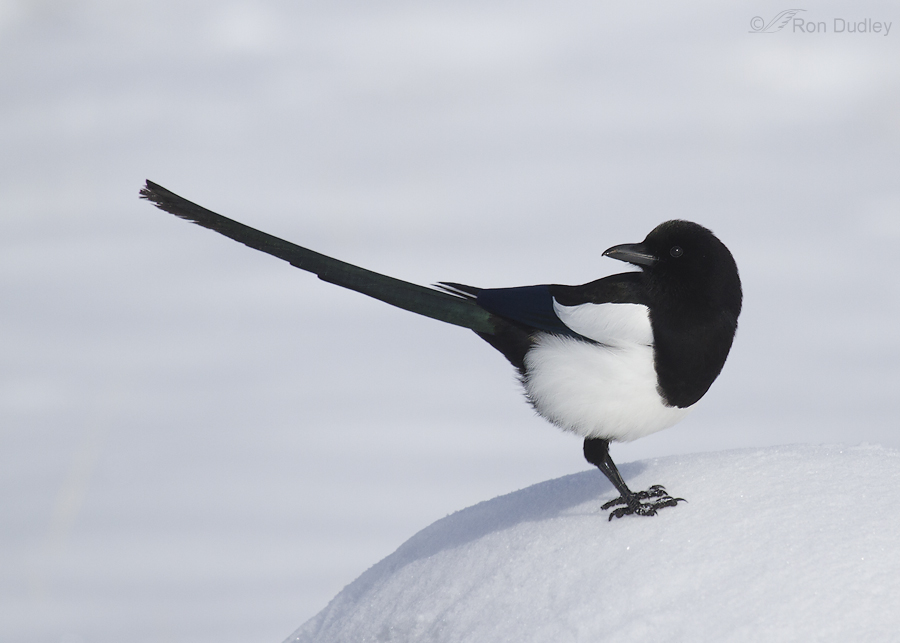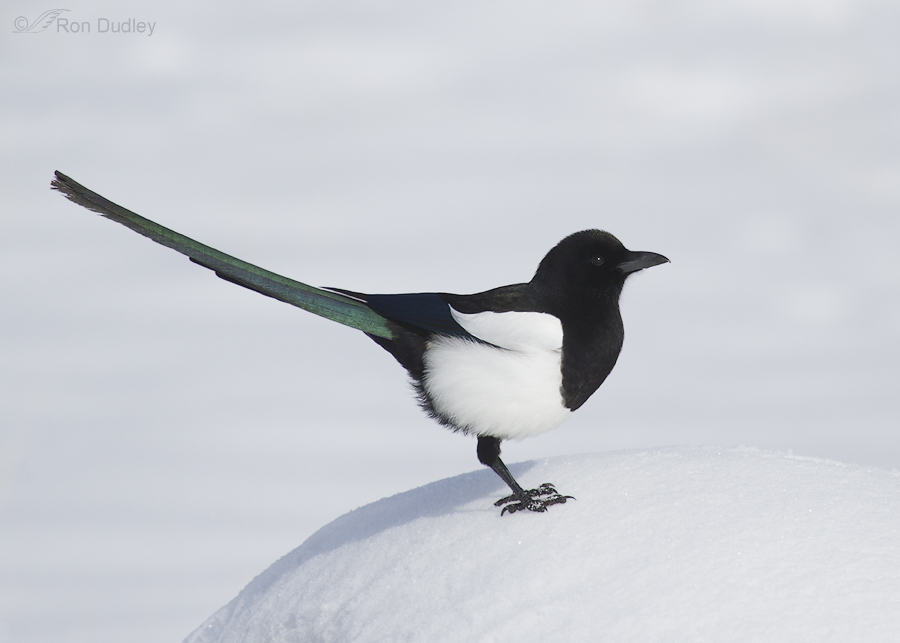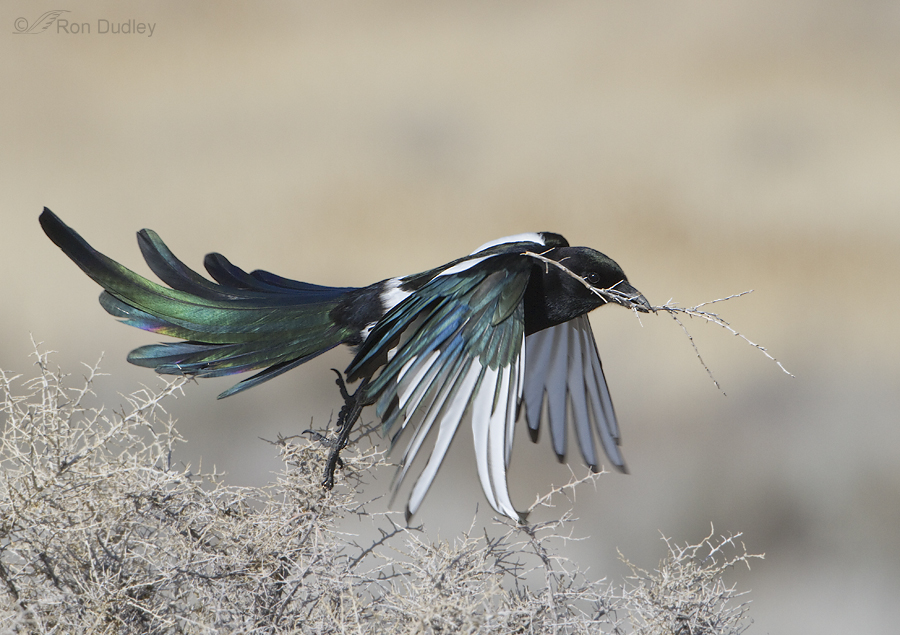Black-billed Magpies are loud, flashy and conspicuous black and white birds. And they’re a challenge to photograph well because of the exposure difficulty – getting detail in the blacks without “blowing out” the whites. I probably discard a higher proportion of shots of this species than I do any other. But if you work hard at it (with a little luck thrown into the mix) you can get some pretty spectacular shots that have detail in the blacks and whites and their showy iridescence.
The actual plumage of these birds is truly black and white, with no other colors. But in the right light the feather structure (and other factors) on the tail and wings of these birds bends the light much like a prism and produces a variety of colors, predominantly blues and greens. When I’m photographing magpies, one of my goals is usually to capture some of that iridescence.

1/4000, f/6.3, ISO 500, 100-400 @ 400mm, natural light
Three days ago I found this magpie perched on a snow-covered boulder on Antelope Island. As you can see the whites are well-exposed but there’s not a lot of detail in the blacks. This is the type of magpie image that I normally wouldn’t do much with except for purposes such as this post (my high shutter speeds were due to the snow and the fact that I was attempting take-off shots).

1/4000, f/6.3, ISO 500, 100-400 @ 400mm, natural light
This is the same bird on the same perch but the image was taken three clicks before the previous one. The iridescence shows up nicely in the tail because of a miniscule difference in the angle of the tail to the sun. There’s also a little more detail in some of the blacks so I prefer this shot to the previous one, even though the pose isn’t quite as interesting for me.

1/4000, f/7.1, ISO 400, 500 f/4, 1.4 tc, natural light
I believe this is the same bird taking off from a different perch 12 minutes later (I was further away so I’m using a different camera and lens). Here the black detail is acceptable, the whites look good and I got some wing iridescence. I wish I had more of it because I like the take-off posture and the eye contact.

1/2000, f/8, ISO 400, 500 f/4, natural light
But when everything comes together the iridescence can be striking. In this image the blues and greens are pretty intense and there’s even hints of reds and yellows in the tail (this is an older shot of a magpie taking off with nesting material that I’ve posted once before).
I’ve spent countless hours trying to get images of magpies with nice iridescence and in my experience I have the best chance if I’m shooting just before mid-morning with the sun coming over my right shoulder and the bird at approximately the angle you see here.
There are also other factors invloved in showing iridescence. Worn feathers subdue the effect and juvenile birds show very little of it.
Ron


Oh! Boy!!! GORGEOUS!!! No Peacock is more beautiful!!!
How come you can make Magpies look more beautiful than peacocks??? And they don’t scream “HELP!” all the time, either…or come at you with their spurs.
The last shot is gorgeous! But they are all stellar, and I am always entertained by these birds and the way that they love to tease my dogs!
Tana, I like it when they tease cats. They do it so very well!
Thanks for sharing these unbelievable shots Ron! Nobody does it better!!@
Very nice of you to say that, Charlotte.
incredible photos of one of my favorite birds!
Great series to show how just a small difference in angle can produce a really different effect. Not to mention the dozens of other little details you touch upon. And then there’s that luck thing which I depend on a lot!
What would we do without a little occasional luck, huh Wally?
Beautiful!
Thank you, Diana.
Ron, those are really great photos capturing a fascinating display. Could this be a diffraction phenomenon? Diffraction gratings have closely spaced parallel grooves that spread white light into its rainbow colors, and the color observed depends on the angle between the light-source-to-grating direction and the grating-to-observer direction. I know practically nothing of avian physiology, but if fine feathers are closely spaced and parallel, they might act like a diffraction grating and produce this effect. I don’t know—I’m just throwing something out there for consideration.
I think diffraction grating is just what it is, Dwynn – just like the effect you get from the grooves on a CD. In this case I’m thinking it may be caused by the fine parallel barbs and barbules of the feather structure. Interesting though, that in this species the iridescence only occurs on the blacks of the wings and tail and not on the other blacks.
Spectacular! No wonder trying to learn bird ID from a tiny photo or drawing in a guide book is such a challenge. You’d never imagine that these are the same. Amazing and beautiful images, Ron! Every morning, I look at my long list new emails. I always save your post for the last, for desert. Thank you so much for sharing your work!
You make a good point about making ID’s from guide books, Mikal. So many birds look very different in varying conditions.
Wow. I had no idea when I looked at the first shot what treat I was in for by the end of the series! That is stunning. Our local grackles flock with starlings and sometimes cowbirds, and in the right light you can see the iridescence on all three, but your shots are so far beyond ‘a flock of grackles”. Thank you!
P.S. Thumbs up for the “blue snow”.
I figured you might notice that snow, Chris. Thought of you while I was processing and took your advice.
Ron, I can’t believe that plumage in the last frame, it’s to die for! We have in P.R. the black grackles which show a lot of iridescence too, but the Boat-tailed grackles at Florida also had and even more pronounced iridescence than the Caribbean grackle.
Thanks, Maria.